Coming of Age : 1976 and the Road to Anti-Racism
Coming of Age : 1976 and the Road to Anti-Racism by Jagdish Patel and Suresh Grover
Coming of Age : 1976 and the Road to Anti-Racism
by Jagdish Patel and Suresh Grover
Create successful ePaper yourself
Turn your PDF publications into a flip-book with our unique Google optimized e-Paper software.
founded by George Padmore in 1937 <strong>and</strong> <strong>the</strong> Pan-African Federation (PAF), founded in 1944.<br />
There were also many important buildings such as <strong>the</strong> West Indian Students Union, <strong>and</strong><br />
India House, in Highgate. India House was opened in 1905 by Henry Hyndman <strong>and</strong> <strong>the</strong><br />
MP Dadabhai Naoroji, <strong>the</strong> Irish Suffragist, Charlotte Despard <strong>and</strong> Bhikaji Cama. This<br />
building became an important meeting place for people from Asian, <strong>the</strong> feminist’s movements<br />
as well as Irish nationalist. Some <strong>of</strong> <strong>the</strong> prominent Indian revolutionaries <strong>and</strong><br />
nationalists were associated with India House, including Shyamji Krishna Verma, Vinayak<br />
Damodar Savarkar, Bhikaji Cama, V.N. Chatterjee, Lala Har Dayal, <strong>and</strong> here <strong>the</strong> ideas around<br />
universal suffrage, self determination <strong>and</strong> equality in Britain were discussed <strong>and</strong> debated.<br />
Our third article charts this journey. From Rebellion <strong>to</strong> Riots was written by Sivan<strong>and</strong>an is an<br />
important article <strong>and</strong> we are pleased <strong>to</strong> be able <strong>to</strong> reproduce it for this publication. As we<br />
will see <strong>the</strong> issues around Internationalism, Pan-Africanism, anti-colonialism <strong>and</strong> <strong>the</strong> importance<br />
<strong>of</strong> solidarity with <strong>the</strong> white working class, were all <strong>the</strong>mes which would characterise <strong>the</strong><br />
British Black Power movement, <strong>and</strong> later <strong>the</strong> Asian Youth Movements, yet <strong>the</strong>y were issues<br />
that were being discussed by black <strong>and</strong> asian organisations in Britain as far back as <strong>the</strong> 1920’s.<br />
The role <strong>of</strong> women within <strong>the</strong> anti-racist movement is deeply under<br />
researched, <strong>and</strong> rarely written about. We have tried <strong>to</strong> identify individuals<br />
who were active in <strong>the</strong> anti racist movement in our timelines, though we<br />
acknowledge that <strong>the</strong>re are many more women present than we have mentioned.<br />
One person who we cannot ignore is Claudia Jones. Claudia Jones was a Trinidadian communist<br />
who came <strong>to</strong> London, via Harlem, courtesy <strong>of</strong> <strong>the</strong> red-baiting sena<strong>to</strong>r Joseph McCarthy. Jones<br />
moved <strong>to</strong> New York with her parents when she was seven. It was <strong>the</strong>re, during <strong>the</strong> campaign <strong>to</strong><br />
defend <strong>the</strong> Scottsboro boys, a group <strong>of</strong> young African-Americans framed for rape in <strong>the</strong> south,<br />
that she joined <strong>the</strong> American Communist party in which she was later <strong>to</strong> play a leading role.<br />
Twice interned for her political beliefs on Ellis Isl<strong>and</strong> - ironically, <strong>the</strong> spiritual home for immigrants<br />
fleeing poverty <strong>and</strong> persecution - she was eventually ordered <strong>to</strong> leave in 1955 <strong>and</strong> sent <strong>to</strong> Engl<strong>and</strong>,<br />
<strong>and</strong> it was here that she established one <strong>the</strong> first Black newspapers, ‘The West Indian Gazette’.<br />
The events <strong>of</strong> 1958, in Notting Hill <strong>and</strong> Nottingham, <strong>and</strong> <strong>the</strong> murder Kelso Cochrane in 1959, had<br />
a pr<strong>of</strong>ound impact on black <strong>and</strong> asian communities across Britain, <strong>and</strong> Claudia was determined<br />
<strong>to</strong> do something. “We need something <strong>to</strong> get <strong>the</strong> taste <strong>of</strong> Notting Hill out <strong>of</strong> our mouths,” she<br />
said. “Someone suggested we should hold a carnival,” says Donald Hinds, who was in <strong>the</strong> room<br />
at <strong>the</strong> time. “We all started laughing because it was so cold <strong>and</strong> carnival is this out-on-<strong>the</strong>-street<br />
thing. It seemed like a ridiculous suggestion.” But Jones had o<strong>the</strong>r ideas <strong>and</strong> set about making<br />
arrangements. A few months later, on January 30, 1959, London’s first Caribbean carnival was<br />
held in St Pancras <strong>to</strong>wn hall. Televised by <strong>the</strong> BBC for Six-Five Special - a forerunner <strong>to</strong> Top Of<br />
<strong>Coming</strong> <strong>of</strong> <strong>Age</strong> | 17<br />
<strong>Coming</strong> <strong>of</strong> <strong>Age</strong> Final version 16.10.indd 17 17/10/2017 12:06







